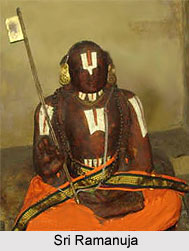 The architectural brilliance of the contemporary artists is revealed from the delicate carvings made on the temple walls. The architectural grandeur provides an additional grand magnificence to the traditional temple. The structural design of the temple testifies the architectural excellence of the contemporary period. The shrine for Sri Ramanuja is located at the very spot where Lord Narayana and Lakshmi gave darshan in disguise to this illustrious Acharya and also the presiding deity of the Temple Lord Ramanuja. The image of Ramanuja enshrined in the sanctum faces east and is placed in the posture of the anjali hasta with his staff (danda). A small eight-pillared mandapa of the Vijayanagara age is attached to this shrine and the temple tank called Anushtanakulam is situated in front. This entire structure itself bears the evidence of the architectural craftsmanship. The royal emblem of the house of Vijayanagara, depicting a Sri Ramanuja, boar (Varaha) with the sun and moon, is seen chiseled on the outer wall of the sanctum, this emblem indicates that this shrine was constructed or rebuilt or renovated during the reign of the Vijayanagara kings who rendered yeoman service to Vaishnavism.
The architectural brilliance of the contemporary artists is revealed from the delicate carvings made on the temple walls. The architectural grandeur provides an additional grand magnificence to the traditional temple. The structural design of the temple testifies the architectural excellence of the contemporary period. The shrine for Sri Ramanuja is located at the very spot where Lord Narayana and Lakshmi gave darshan in disguise to this illustrious Acharya and also the presiding deity of the Temple Lord Ramanuja. The image of Ramanuja enshrined in the sanctum faces east and is placed in the posture of the anjali hasta with his staff (danda). A small eight-pillared mandapa of the Vijayanagara age is attached to this shrine and the temple tank called Anushtanakulam is situated in front. This entire structure itself bears the evidence of the architectural craftsmanship. The royal emblem of the house of Vijayanagara, depicting a Sri Ramanuja, boar (Varaha) with the sun and moon, is seen chiseled on the outer wall of the sanctum, this emblem indicates that this shrine was constructed or rebuilt or renovated during the reign of the Vijayanagara kings who rendered yeoman service to Vaishnavism.
A striking feature of this shrine is that the image of Ramanuja directly faces east towards the temple of Varadaraja Perumal in Kanchi and the two magnificent temple towers, east and west of this hoary temple are clearly visible from inside this shrine. The brilliant artistry and the excellence of the architecture enhance the splendor of the temple.





















